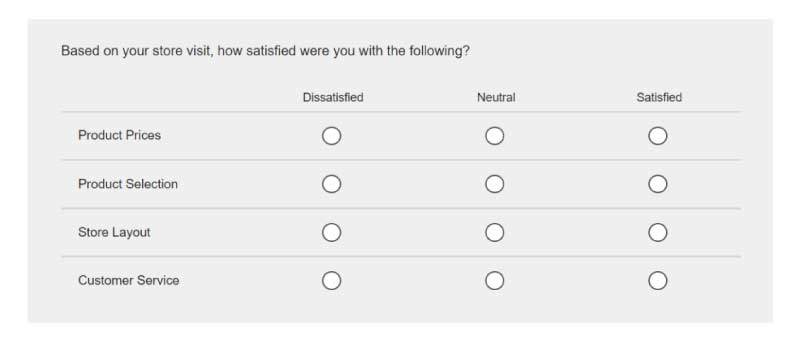Surveys can be conducive for getting a hold on what your customers are and aren’t liking about the brand. A correctly framed survey can help a brand reach the core of its strengths and weaknesses.
In 2021, Martech Alliance published a report revealing that nearly half (48%) of respondents accept that the customer experience they deliver falls short and is significantly below what their customers expect. One doesn’t need rocket science to figure out why this happens – brands aren’t listening to their customers.
It is essential for brands to accurately determine customers’ feelings about their goods, services, or general business procedures. And the best way to do this is with surveys.
Customer satisfaction surveys allow businesses to learn what their target market thinks of their services. While these can be done online and offline, the former might be a better option to capitalize on since nearly 87% of consumers read online reviews for local businesses.
Types of survey questions
Surveys come in handy for gathering inputs from a wide range of audiences, including clients, coworkers, potential customers, friends, and even family. Before beginning them, brands need to focus on the type of questions they want to include.
1) Open-ended questions
Most customers encounter specific pre-set answer options to select from while explaining their experiences with the brand. Respondents feel it is unfair as they cannot provide feedback in their own words. This is where open-ended questions come to the brand’s rescue. It allows them to respond more meaningfully and helps find possibilities that they (brands) might miss. Let’s see some of the examples;
- How do you think we could improve?
- What could be a better combination to wear at a wedding?
- What is it like to live in Paris?
Companies deploy text analysis software to examine reviews. Text boxes are preferable for presenting qualitative data. However, open-ended questions could be better when assessing data, as written responses are difficult to measure.
This brings us to the next type.
2) Close-ended questions
These questions present respondents with predetermined response possibilities. Typically, a customer can respond to those with a straightforward yes or no, a predetermined number on a fixed point scale, or a specific piece of information.
For example, an NPS (Net Promoter Score) survey requests respondents to rate a brand on a scale of 0 to 10 according to how likely they are to recommend it to their friends and family. Similarly, other metrics like CSAT and CES survey questions ask respondents to score their experience and effort by choosing from a list of options.
3) Multiple-choice questions
These are one of the most common forms of survey questions; they enable respondents to pick one or more choices from predetermined responses. In the process, it provides the firm with good data for analysis, is intuitive, simple to use in many ways, and offers mutually exclusive options. Customers will find it simpler to complete the survey because the answer alternatives are predetermined. For example;
Why don’t you eat ice cream at Blue Bell Creameries parlor?
- I don’t like the flavors
- It’s too expensive
- The service is bad
- I don’t know
4) Likert Scale
It is sometimes essential to measure customers’ perceptions, opinions, and attitudes to understand the impact of steps companies are putting in to enhance customer experience. Respondents often come across survey questions that ask to select from “neither agreed nor disagreed” or “totally agreed/disagreed.” These questions are based on a Likert scale, which suits best when a brand needs to ask its audience about a new product release, customer loyalty, a recent development at the firm, the success of a huge event, etc. For example;
How satisfied are you with the customer support at Jet Blue?
- Very satisfied
- Extremely satisfied
- Neither satisfied nor dissatisfied
- Not so satisfied
- Not satisfied at all
5) Matrix questions
These can be the best format if you wish to ask several questions in a sequence with the same possible answers. A succession of Likert scale or rating scale questions can be effective as a matrix question. Many topics can be made simpler with matrix questions, but it’s crucial to utilize them responsibly.
While matrix questions can greatly simplify large-scale surveys, some respondents may need clarification, and they are only sometimes ideal for mobile devices. For example;
her important form of a question to gauge a broad sense of people’s perspectives is rating questions. The 1-5 star rating, with hearts or smiles you see, falls in this category. They display a scale of response possibilities from any range (0 to 5, 1 to 10, etc.). The respondent chooses the number that best captures their answer. For example;

6) Rating questions
Another important form of a question to gauge a broad sense of people’s perspectives is rating questions. The 1-5 star rating, with hearts or smiles you see, falls in this category. They display a scale of response possibilities from any range (0 to 5, 1 to 10, etc.). The respondent chooses the number that best captures their answer. For example;
- How likely would you recommend the brand to your friends on a scale of 1 to 10?
- How would you rate our service out of 5?
7) Demographic questions
Sometimes brands require to find out their target audience and garner better insights. These questions help gather information about the respondent’s city, income level, and background. It is helpful in further analyzing collected data using demographic questions to classify audiences depending on their characteristics and activities. For example;
- What is your gender?
- Which industry are you currently employed in?
Customer satisfaction surveys give brands the opportunity to identify the aspects working or failing for them, thereby providing a chance to address the weak points and build on the strengths. Further, it helps obtain suggestions about other ways to improve goods or service delivery by allowing customers to voice their opinions.




